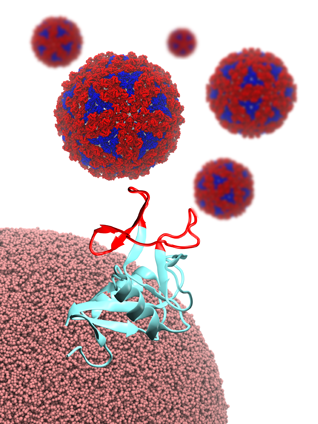Dr Aleksandra Watson
Biography
As a Sir Henry Wellcome Postdoctoral Fellow, I am investigating the key regulatory role of the NuRD nucleosome remodelling complex in cellular development and cancer progression by studying its structure and composition.
I completed my education in the Middle East and in 2004 I attained an MBiochem in Molecular and Cellular Biochemistry from the University of Oxford. During my final year, and with a Wellcome Trust-funded Summer Studentship, I worked in the laboratories of Professor Jane Endicott, and Dr Chris Norbury on the structural characterisation of the human cytoplasmic poly(A)polymerase cid1. As a Graduate Scholar at St Hilda's College, I completed my Medical Research Council funded DPhil in Clinical Medicine under Dr. Chris O'Callaghan at the Henry Wellcome Building for Molecular and Cellular Physiology, Oxford University. Here, I investigated the structural nature of protein-protein interactions in immune surveillance, successfully solving structures of three distinct immunological molecules, and subsequently identifying binding features using biophysical, computational and molecular techniques.
Qualifications
2004-2009: D.Phil Clinical Medicine
“Molecular structure and function of C-type lectin-like molecules in innate immunity.”
Institution: Henry Wellcome Building for Molecular Physiology, University of Oxford.
2000-2004: MBiochem
Molecular and Cellular Biochemistry
Institution: University College, University of Oxford
Research
“The structural basis of the interactions of the NuRD co-repressor complex”
The length of human DNA is approximately 2 meters, exceeding that of the compartment in which it is packaged by 40,000 fold. In eukaryotic cells, compaction of this genetic material is achieved by winding DNA around small, basic scaffold proteins called histones. However, this packaging of DNA (into chromatin), renders genes inaccessible to proteins required for copying genetic material from DNA into RNA, and subsequently into proteins (essential for processes including cell development and cancer progression). Therefore, chromatin structure is tightly controlled both by remodelling/rearrangement of histones and by the addition/removal of different tags on these proteins, which controls the recruitment of particular complexes to specific genes. These activities are coupled by the nucleosome remodelling and deacetylase (NuRD) complex.
I am working towards a structural understanding of the NuRD complex and its role in transcriptional repression. My research is based at the Biochemistry Department (Cambridge) in Prof E.D. Laue’s laboratory, with long-term collaborations with Dr B.D. Hendrich (Cambridge), and at EMBL (Grenoble and Hamburg), the Structural Genomics Consortium (Oxford), and the University of Antwerp (Belgium).
Selected Publications
Articles
1. Watson, A.A., and O'Callaghan, C.A. (2011). Molecular Analysis of the Interaction of the Snake Venom Rhodocytin with the Platelet Receptor CLEC-2. Toxins, 3(8), 991-1003.
2. Watson, A.A., Christou, C.M., O'Callaghan, C.A. Expression, purification and crystallization of the human UL16-binding protein ULBP1. Protein Expr Purif. 2011 Sep;79(1):44-8. Epub 2011 May 7.
3. Watson, A.A., Lebedev, A.A., Hall, B.A., Fenton-May, A.E., Vagin, A.A., Dejnirattisai, W., Felce, J., Mongkolsapaya, J., Palma, A.S., Liu, Y., Feizi, T., Screaton, G.R., Murshudov, G.N., O'Callaghan, C.A. (2011). Structural Flexibility of the Macrophage Dengue Virus Receptor CLEC5A: IMPLICATIONS FOR LIGAND BINDING AND SIGNALING. J Biol Chem. 2011 Jul 8;286(27):24208-18. Epub 2011 May 12. F1000 Recommendation.
4. Watson, A.A., and O'Callaghan, C.A. (2009). Crystallization and X-ray diffraction analysis of human CLEC5A (MDL-1) - a Dengue virus receptor. Acta Crystallogr Sect F Struct Biol Cryst Commun. 2010 Jan 1;66(Pt 1):29-31.
5. Watson, A.A., Christou, C.M., James, J.R., Fenton-May, A.E., Moncayo, G.E., Mistry, A.R., Davis, S.J., Gilbert, R.J., Chakera, A., O’Callaghan, C.A. (2009).The Platelet Receptor CLEC-2 is Active as a Dimer. Biochemistry. Nov 24;48(46):10988-96.
6. Watson, A.A., and O'Callaghan, C.A. (2009). CLEC5. UCSD-Nature Molecule Pages. Published online: 26 Aug 2009 doi:10.1038/mp.a004147.01
7. Watson, A.A., Eble, J.A., and O'Callaghan, C.A. (2008). Crystal structure of rhodocytin, a ligand for the platelet-activating receptor CLEC-2. Protein Sci 17, 1611-1616.
8. Christou, C.M., Pearce, A.C., Watson, A.A., Mistry, A.R., Pollitt, A.Y., Fenton-May, A.E., Johnson, L.A., Jackson, D.G., Watson, S.P., and O'Callaghan, C.A. (2008). Renal cells activate the platelet receptor CLEC-2 through podoplanin. Biochem J 411, 133-140.
9. Watson, A.A., Brown, J., Harlos, K., Eble, J.A., Walter, T.S., and O'Callaghan, C.A. (2007). The crystal structure and mutational binding analysis of the extracellular domain of the platelet-activating receptor CLEC-2. J Biol Chem 282, 3165-3172.
10. Watson, A.A., and O'Callaghan, C.A. (2005). Crystallization and X-ray diffraction analysis of human CLEC-2. Acta Crystallograph Sect F Struct Biol Cryst Commun 61(Pt 12), 1094-1096.
Abstracts
11. O'Callaghan, C.A., Watson, A.A., Fenton-May, A.E., Christou, C.M. (2009). Structure and function of the activating receptor CLEC-2. Journal of Immunology 182, 134.10.
12. Watson, A.A., Fenton-May, A.E., Christou, C.M., and O'Callaghan, C.A. (2008). Structure and function of the CLEC-2 receptor and its ligands: 2.4. Immunology. 125 Supplement 1:13.
Teaching
• Natural Sciences Cells IA Supervisor at Christ’s College, Cambridge to Natural Science undergraduate students (current).
• Supervision of PhD students, Department of Biochemistry, Cambridge (2010-current).
• Supervision of Part II students, Department of Biochemistry, Cambridge (2011).
• Supervision of a Nuffield Research project 6th Form College Summer Student, Department of Biochemistry, Cambridge (2011).
• College Amanuensis for candidates during Undergraduate Biochemistry Examinations (University College, Oxford, 2006).
External Activities
• Organisation and chair of the Biochemistry Department Structural Biology Seminar Series, University of Cambridge (2010-current).
